Topics
Category
Era
Washburn A Mill Explosion, 1878
On the evening of May 2, 1878, the Washburn A Mill exploded in a fireball, hurling debris hundreds of feet into the air. In a matter of seconds, a series of thunderous explosions—heard ten miles away in St. Paul—destroyed what had been Minneapolis' largest industrial building, and the largest mill in the world, along with several adjacent flour mills. It was the worst disaster of its type in the city's history, prompting major safety upgrades in future mill developments.
The massive A Mill, only four years old at the time, had been built by Cadwallader Washburn, a businessman from LaCrosse, Wisconsin, in the heart of Minneapolis on the Mississippi River, near St. Anthony Falls. The seven-story flour mill was powered with river water, which was diverted through a canal that ran inside its lower level. With two hundred workers, it was one of the city's largest employers.
At six o'clock that evening, the mill's large day crew completed its shift. Fourteen men who made up the night crew arrived. An hour later, three deafening explosions echoed out, reverberating in waves all over town. All fourteen workers were killed. Within minutes, the fire had spread to the adjacent Diamond and Humboldt mills. They also exploded, killing four more workers.
The city's fire department worked all night to contain the fire. Their efforts were futile. The intense heat prevented firefighters from setting up rigs and hoses close enough to the site to have much impact.
The next day, on May 3, the Minneapolis Tribune told its readers, "Minneapolis has met with a calamity, the suddenness and horror of which it is difficult for the mind to comprehend."
At the inquest into the deaths of the eighteen workers, John A. Christian, the A Mill's manager, explained that rapidly burning flour dust had caused the disaster. His explanation was later confirmed by two University of Minnesota professors, S.F. Peckham and Louis W. Peck, who reviewed a series of controlled experiments that caused flour dust to explode. Peckham and Peck concluded that two of the millstones, running dry, had rubbed against each other, causing a spark that ignited the dust.
As the furor over the explosions began to subside, the Tribune speculated about the impact of the event on the local milling industry, now that one-third to one-half of the city's production capacity had been destroyed. The newspaper noted that Minneapolis had recently surpassed St. Louis and Buffalo in milling production and was now the country's leading flour producer.
Cadwallader Washburn, who had rushed to town from his Wisconsin home after hearing news of the calamity, announced that he would rebuild, even as the embers from his destroyed plant were still glowing.
Washburn kept his word. By 1880, his new A Mill was up and running. It was safer and more technologically advanced than its predecessor, with a greater production capacity. The milling magnate opened his new plant in time to take advantage of the economic boom that Minneapolis would experience during the last two decades of the nineteenth century and into the twentieth. The city's milling production continued to increase, peaking during World War I.
The A Mill continued to operate for several more decades, even as the local milling industry declined. It finally closed in 1965, remaining vacant until a 1991 fire destroyed the building.
In 2003, the Mill City Museum, which incorporates the ruins of the A Mill, opened to the public. The museum interprets Minneapolis's milling history and the role of water power in promoting the city's growth during its early decades. Visitors who ride the museum's Flour Tower elevator—an educational presentation that offers a glimpse into each of the mill's floors—hear a thundering boom intended to evoke the 1878 explosion.
Another reminder of the nineteenth century disaster is located four miles away in Minneapolis' Lakewood Cemetery. There, a monument erected in 1885 honors the memory of the eighteen men who were killed. A plaque lists their names. Just below it, the monument's engravings include a sheaf of wheat, a millstone, and a broken gear.
Bibliography
Huntzicker, William E. "How Newspapers Reported a Milling Disaster 125 Years Ago." Hennepin History 62, no. 2 (Spring 2003): 18–34.
Kane, Lucille M. The Falls of St. Anthony, the Waterfall that Built Minneapolis. St. Paul: Minnesota Historical Society Press, 1987.
Kelsey, Kerck. Remarkable Americans: The Washburn Family. Gardiner, ME: Tilbury House Publishers, 2008.
Related Resources
Primary Sources
"Among the Ruins." Minneapolis Tribune, May 3, 1878.
"Around the Ruins." Minneapolis Tribune, May 4, 1878.
"After the Disaster." Minneapolis Tribune, May 8, 1878.
"Death and Destruction." Daily Globe, May 3, 1878
http://chroniclingamerica.loc.gov/lccn/sn83025287/1878-05-03/ed-1/seq-1/
The Disaster." Daily Globe, May 4, 1878
http://chroniclingamerica.loc.gov/lccn/sn83025287/1878-05-04/ed-1/
"The Great Disaster." Minneapolis Tribune, May 6, 1878.
P1455 and M600
Edwin H. Brown and Family Papers, 1866–1960
Manuscript Collection, Minnesota Historical Society, St. Paul
http://www.mnhs.org/library/findaids/p1455.xml
Description: Family papers document many aspects of the lives of members of the Brown, Hall, and Christian families, including the Minneapolis flour milling industry (1860s-1870s) and especially the Washburn A Mill explosion.
"A Terrible Disaster." Worthington Advance, May 9, 1878.
http://chroniclingamerica.loc.gov/lccn/sn85025620/1878-05-09/ed-1/seq-1/
A/.D332
William De la Barre Papers, 1861–1924
Manuscript Collection, Minnesota Historical Society, St. Paul
Description: Papers relating to De la Barre, an engineer who was employed by Minneapolis waterpower owners and grain millers. There is information in the collection on the explosion of the Washburn A mill.
Secondary Sources
Bicha, Karl D. C.C. Washburn and the Upper Mississippi Valley. New York: Garland Publishing Inc., 1995.
"Explosion of the Washburn 'A' Mill." Eventually News 1, no. 27 (April 28, 1920): 1–7, 12.
Frame, Robert M. "'The Minneapolis Horror': The Great Mill Explosion of 1878." Old Mill News 9, no. 1 (January 1981): 8–11.
"The Great Mill Explosion and Fire of 1878." Hennepin County History 16–2, no. 62 (April 1956): 9–10.
Peckham, Stephen Farnum. The Dust Explosions at Minneapolis, May 2, 1878, and Other Dust Explosions. New York: n.p., 1908.
Pennefeather, Shannon M. ed. Mill City: A Visual History of the Minneapolis Mill District. St. Paul: Minnesota Historical Society Press, 2003.
Taylor, R.J. The Washburn Mill: A Complete Solution of the Mysterious Causes of the Blowing Up of the Washburn Mill on the 2d Day of May, 1878. Minneapolis: Galesburg Printing and Publishing Company, 1880.
Wilson, Bonnie. "Eyewitness." Minnesota History 58, nos. 5 and 6 (spring/summer 2003): 250.
Web
Mill City Museum.
http://www.mnhs.org/millcity
National Register of Historic Places. Washburn A. Mill Complex, Minneapolis, 1971.
https://npgallery.nps.gov/NRHP/GetAsset/22cde735-aa99-4b5e-8c76-3d687360e392/?branding=NRHP
Related Images

Artist's depiction of the explosion at Washburn A Mill, Minneapolis
Photograph altered by an artist to illustrate the Washburn A Mill explosion, 1878.
Public domain
Holding Location
Articles
More Information
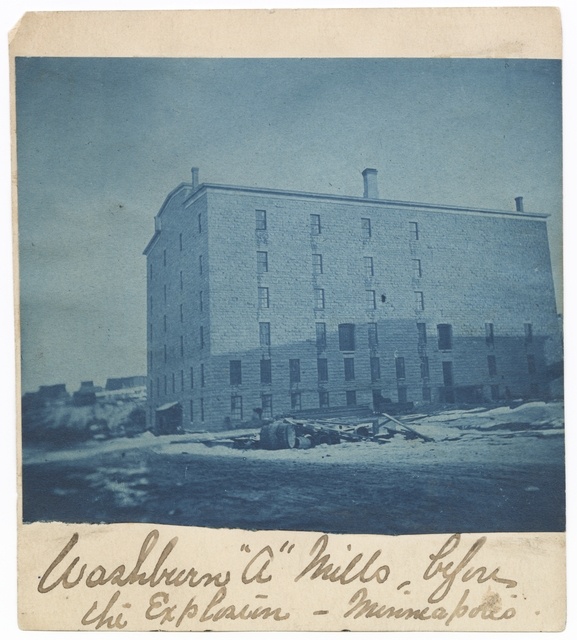
Washburn A Mill, ca. 1877
Cyanotype of Washburn A Mill, ca. 1877, before the 1878 flour-dust explosion.
Holding Location
Minnesota Historical Society
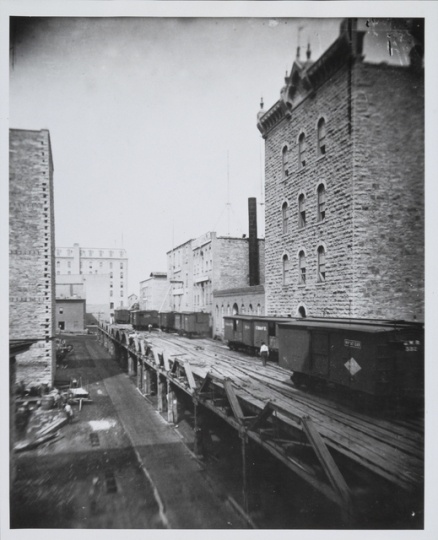
Minneapolis flour mills before the 1878 Washburn A Mill explosion
Pillsbury A Mill elevator and surrounding buildings in flour mill row before the Washburn A Mill explosion in 1878 (ca. 1877). Shown are, left to right: Washburn A Mill, Crown Mill, Empire Mill, Pillsbury B Mill, Excelsior Mill, paper mill, and Northwestern Mill.
Public domain
Holding Location
Articles
More Information

Ruins of Pettit, Zenith, and Galaxy Mills after Washburn A Mill explosion, Minneapolis
Ruins of the Pettit, Zenith, and Galaxy Mills after Washburn A Mill explosion on the Mississippi Riverfront, 1878.
Public domain
Holding Location
Articles
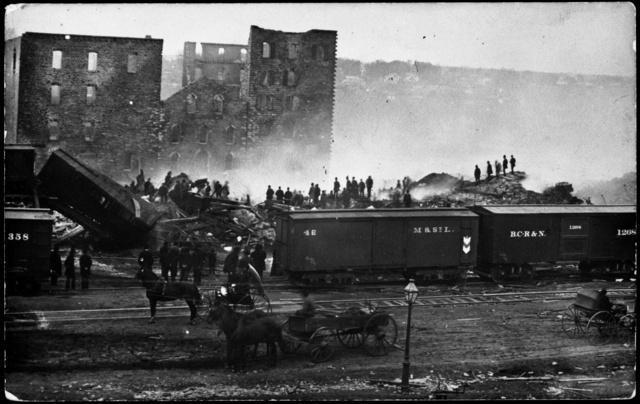
Ruins of Washburn A Mill, 1878
The ruins of Washburn A Mill in Minneapolis after flour dust sparked an explosion inside the building, 1878.
Holding Location
Articles
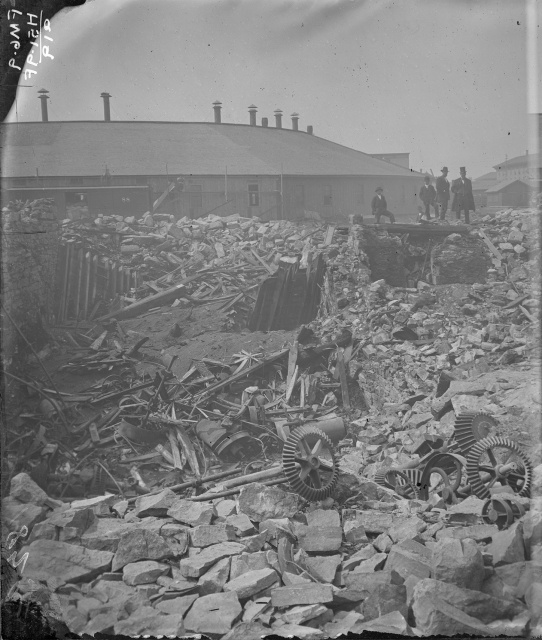
Ruins of Washburn A Mill after explosion, Minneapolis
Ruins of Washburn A Mill after explosion, Minneapolis, 1878. Photograph by Jacoby.
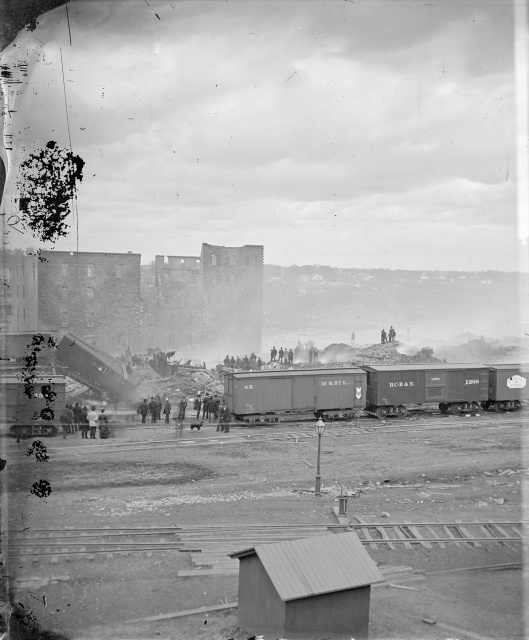
Ruins of Washburn A Mill and other mills after explosion, Minneapolis
Ruins of Washburn A Mill and other mills after explosion, Minneapolis, 1878. Photograph by Jacoby.
Holding Location
Articles
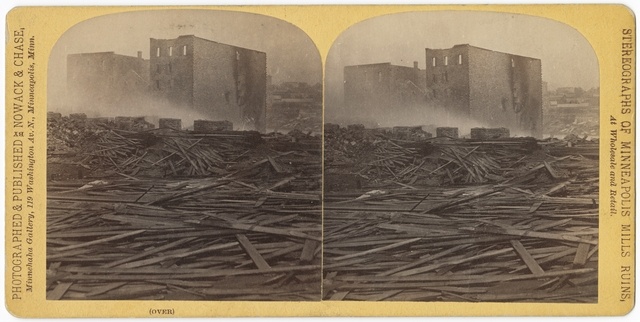
Ruins of Pettit, Zenith, and Galaxy Mills after the Washburn A Mill explosion, Minneapolis
Ruins of Pettit, Zenith, and Galaxy Mills after the Washburn A Mill explosion, Minneapolis, 1878. Stereograph by Nowack & Chase.
Holding Location
Articles
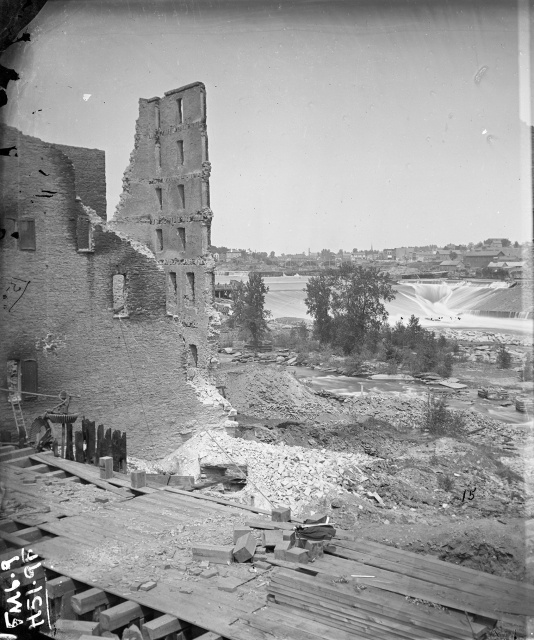
Ruins of Washburn A Mill after explosion, Minneapolis
Ruins of Washburn A Mill after explosion, Minneapolis, 1878. Photograph by Jacoby.
Holding Location
Articles
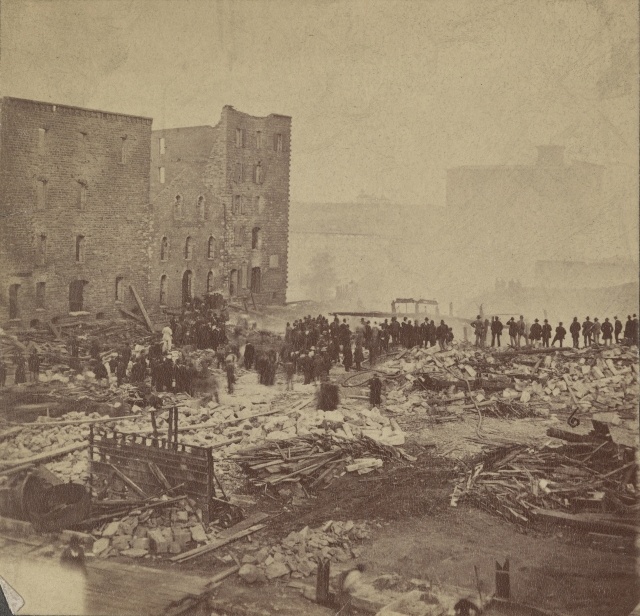
Ruins of Washburn A Mill and other mills after explosion
The ruins of Washburn A Mill and other mills after a flour-dust explosion, 1878.
Holding Location
Articles
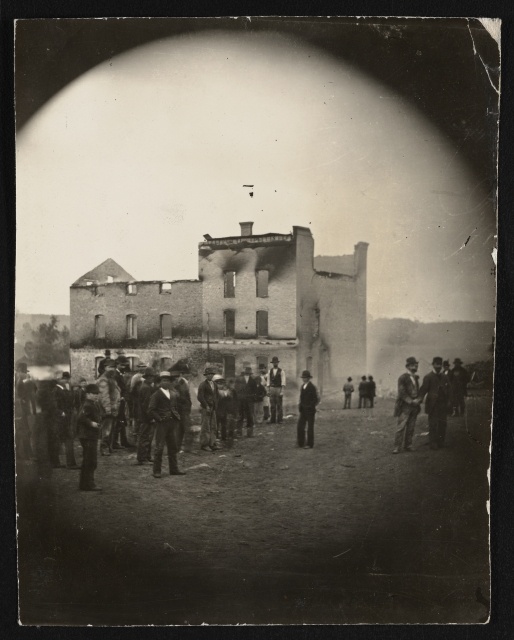
Ruins of a building near Washburn A Mill
The ruins of a building near the Washburn A Mill after a flour-dust explosion. Photograph by Jacoby, 1878.
Holding Location
Articles
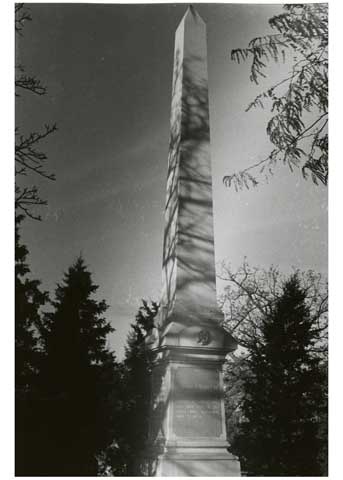
Millers' Monument (millers killed in Washburn A Mill explosion in 1878), Lakewood Cemetery, Minneapolis
Monument to millers killed in the Washburn A Mill explosion in 1878, Lakewood Cemetery, Minneapolis.
Holding Location
Articles
Related Articles
Turning Point
On May 3, 1878, just one day after the A Mill is obliterated, owner Cadwallader Washburn announces that he will rebuild it.
Chronology
1874
1878
1880
1885
1965
1991
2003
Bibliography
Huntzicker, William E. "How Newspapers Reported a Milling Disaster 125 Years Ago." Hennepin History 62, no. 2 (Spring 2003): 18–34.
Kane, Lucille M. The Falls of St. Anthony, the Waterfall that Built Minneapolis. St. Paul: Minnesota Historical Society Press, 1987.
Kelsey, Kerck. Remarkable Americans: The Washburn Family. Gardiner, ME: Tilbury House Publishers, 2008.
Related Resources
Primary Sources
"Among the Ruins." Minneapolis Tribune, May 3, 1878.
"Around the Ruins." Minneapolis Tribune, May 4, 1878.
"After the Disaster." Minneapolis Tribune, May 8, 1878.
"Death and Destruction." Daily Globe, May 3, 1878
http://chroniclingamerica.loc.gov/lccn/sn83025287/1878-05-03/ed-1/seq-1/
The Disaster." Daily Globe, May 4, 1878
http://chroniclingamerica.loc.gov/lccn/sn83025287/1878-05-04/ed-1/
"The Great Disaster." Minneapolis Tribune, May 6, 1878.
P1455 and M600
Edwin H. Brown and Family Papers, 1866–1960
Manuscript Collection, Minnesota Historical Society, St. Paul
http://www.mnhs.org/library/findaids/p1455.xml
Description: Family papers document many aspects of the lives of members of the Brown, Hall, and Christian families, including the Minneapolis flour milling industry (1860s-1870s) and especially the Washburn A Mill explosion.
"A Terrible Disaster." Worthington Advance, May 9, 1878.
http://chroniclingamerica.loc.gov/lccn/sn85025620/1878-05-09/ed-1/seq-1/
A/.D332
William De la Barre Papers, 1861–1924
Manuscript Collection, Minnesota Historical Society, St. Paul
Description: Papers relating to De la Barre, an engineer who was employed by Minneapolis waterpower owners and grain millers. There is information in the collection on the explosion of the Washburn A mill.
Secondary Sources
Bicha, Karl D. C.C. Washburn and the Upper Mississippi Valley. New York: Garland Publishing Inc., 1995.
"Explosion of the Washburn 'A' Mill." Eventually News 1, no. 27 (April 28, 1920): 1–7, 12.
Frame, Robert M. "'The Minneapolis Horror': The Great Mill Explosion of 1878." Old Mill News 9, no. 1 (January 1981): 8–11.
"The Great Mill Explosion and Fire of 1878." Hennepin County History 16–2, no. 62 (April 1956): 9–10.
Peckham, Stephen Farnum. The Dust Explosions at Minneapolis, May 2, 1878, and Other Dust Explosions. New York: n.p., 1908.
Pennefeather, Shannon M. ed. Mill City: A Visual History of the Minneapolis Mill District. St. Paul: Minnesota Historical Society Press, 2003.
Taylor, R.J. The Washburn Mill: A Complete Solution of the Mysterious Causes of the Blowing Up of the Washburn Mill on the 2d Day of May, 1878. Minneapolis: Galesburg Printing and Publishing Company, 1880.
Wilson, Bonnie. "Eyewitness." Minnesota History 58, nos. 5 and 6 (spring/summer 2003): 250.
Web
Mill City Museum.
http://www.mnhs.org/millcity
National Register of Historic Places. Washburn A. Mill Complex, Minneapolis, 1971.
https://npgallery.nps.gov/NRHP/GetAsset/22cde735-aa99-4b5e-8c76-3d687360e392/?branding=NRHP













